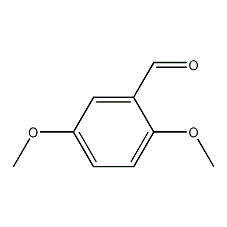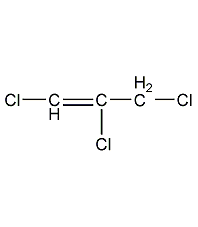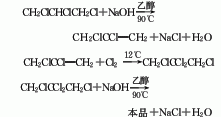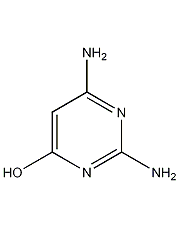
Structural formula
| Business number | 0175 |
|---|---|
| Molecular formula | C4H6N4O |
| Molecular weight | 126.12 |
| label |
2,4-Diamino-6-hydroxypyrimidine, 2,6-Diamino-4-pyrimidinol, 2,6-Diamino-4-pyrimidinone, Heterocyclic compounds |
Numbering system
CAS number:56-06-4
MDL number:MFCD00149408
EINECS number:200-254-4
RTECS number:None
BRN number:125006
PubChem number:24278824
Physical property data
1. Properties: Yellow needle-like crystals
2. Density (g/mL, 25/4?): Undetermined
3. Relative vapor density (g/mL , air=1): Undetermined
4. Melting point (ºC): 260~270
5. Boiling point (ºC, normal pressure): Undetermined
6. Boiling point (ºC, 5.2kPa): Undetermined
7. Refractive index: Undetermined
8. Flash point (ºC): Undetermined
9. Specific rotation (º): Undetermined
10. Autoignition point or ignition temperature (ºC): Undetermined
11. Vapor pressure (kPa, 25ºC): Undetermined
12. Saturated vapor pressure (kPa, 60ºC): Undetermined
13. Heat of combustion (KJ/mol): Undetermined
14. Critical temperature (ºC): Undetermined
15. Critical pressure (KPa): Undetermined
16. Log value of oil-water (octanol/water) partition coefficient: Undetermined
17. Explosion upper limit (%, V/V): Undetermined
18. Explosion lower limit (%, V/V): Undetermined
19. Solubility: Not determined
Toxicological data
None
Ecological data
None
Molecular structure data
1. Molar refractive index: 32.78
2. Molar volume (cm3/mol): 78.8
3. Isotonic specific volume (90.2K ): 262.2
4. Surface tension (dyne/cm): 122.2
5. Polarizability (10-24cm3): 12.99
Compute chemical data
1. Hydrophobic parameter calculation reference value (XlogP): -1.8
2. Number of hydrogen bond donors: 3
3. Number of hydrogen bond acceptors: 4
4. Number of rotatable chemical bonds: 0
5. Number of tautomers: 17
6. Topological molecular polar surface area (TPSA): 93.5
7. Number of heavy atoms: 9
8. Surface charge: 0
9. Complexity: 205
10. Number of isotope atoms: 0
11. Determine the number of atomic stereocenters: 0
12. The number of uncertain atomic stereocenters: 0
13. The number of determined chemical bond stereocenters: 0
14. Uncertain chemical bond stereocenters Quantity: 0
15. Quantity of covalent bond units: 1
Properties and stability
Low toxicity. Operators should wear protective equipment to avoid contact with skin.
Storage method
This product should be sealed and stored away from light.
Plastic bag lined inside and woven bag packed outside. Store in a cool, ventilated, dry place, protected from sun and moisture, and away from fire and heat sources. When transporting, load and unload gently to avoid damage to the packaging.
Synthesis method
Heat and stir guanidine nitrate in sodium methoxide (or 50% NaOH) solution. After refluxing for half an hour, add methyl cyanoacetate dropwise and reflux for 2 hours. After the reaction is completed, heat and recover methanol. Heat water in the residue to dissolve it. When the temperature reaches 80°C, add acetic acid to adjust pH = 8 to precipitate product crystals. Cool to below 20°C, filter, wash and dry to obtain.
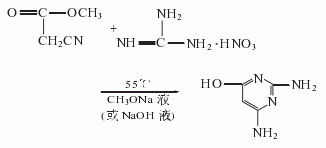
Purpose
For detection of nitrates and nitrites. Organic Synthesis. Pharmaceutical intermediates. It is used in the production of the drug Oncin-M, the antihypertensive drug Minadridine, and the anti-anemia drug folic acid.
extended-reading:https://www.cyclohexylamine.net/cas-1067-33-0-dibutyl-tin-diacetate/extended-reading:https://www.newtopchem.com/archives/846extended-reading:https://www.bdmaee.net/tmg-nnn%e2%80%b2n%e2%80%b2-tetramethylguanidine-cas80-70-6/extended-reading:https://www.morpholine.org/category/morpholine/page/3/extended-reading:https://www.newtopchem.com/archives/40383extended-reading:https://www.bdmaee.net/dabco-bdma-catalyst-cas103-83-3-evonik-germany/extended-reading:https://www.newtopchem.com/archives/1037extended-reading:https://www.newtopchem.com/archives/762extended-reading:https://www.newtopchem.com/archives/44586extended-reading:https://www.cyclohexylamine.net/dabco-eg-pc-cat-td-33eg-niax-a-533/

